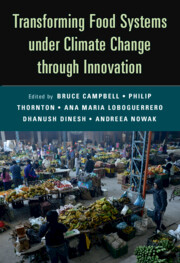16 results
Efficacy and safety of a 4-week course of repeated subcutaneous ketamine injections for treatment-resistant depression (KADS study): randomised double-blind active-controlled trial
-
- Journal:
- The British Journal of Psychiatry / Volume 223 / Issue 6 / December 2023
- Published online by Cambridge University Press:
- 14 July 2023, pp. 533-541
- Print publication:
- December 2023
-
- Article
-
- You have access
- Open access
- HTML
- Export citation
Acknowledgements
-
- Book:
- Transforming Food Systems Under Climate Change through Innovation
- Published online:
- 19 January 2023
- Print publication:
- 19 January 2023, pp xviii-xviii
-
- Chapter
-
- You have access
- Open access
- HTML
- Export citation
Plate Section (PDF Only)
-
- Book:
- Transforming Food Systems Under Climate Change through Innovation
- Published online:
- 19 January 2023
- Print publication:
- 19 January 2023, pp 231-231
-
- Chapter
-
- You have access
- Open access
- HTML
- Export citation

Transforming Food Systems Under Climate Change through Innovation
-
- Published online:
- 19 January 2023
- Print publication:
- 19 January 2023
-
- Book
-
- You have access
- Open access
- Export citation
Reviews
-
- Book:
- Transforming Food Systems Under Climate Change through Innovation
- Published online:
- 19 January 2023
- Print publication:
- 19 January 2023, pp v-vi
-
- Chapter
-
- You have access
- Open access
- HTML
- Export citation
Index
-
- Book:
- Transforming Food Systems Under Climate Change through Innovation
- Published online:
- 19 January 2023
- Print publication:
- 19 January 2023, pp 224-230
-
- Chapter
-
- You have access
- Open access
- HTML
- Export citation
Contributors
-
- Book:
- Transforming Food Systems Under Climate Change through Innovation
- Published online:
- 19 January 2023
- Print publication:
- 19 January 2023, pp x-xvii
-
- Chapter
-
- You have access
- Open access
- HTML
- Export citation
2 - Where We Need to Drive Food-System Action
-
-
- Book:
- Transforming Food Systems Under Climate Change through Innovation
- Published online:
- 19 January 2023
- Print publication:
- 19 January 2023, pp 11-22
-
- Chapter
-
- You have access
- Open access
- HTML
- Export citation
15 - Theories of Change for Transformation
-
-
- Book:
- Transforming Food Systems Under Climate Change through Innovation
- Published online:
- 19 January 2023
- Print publication:
- 19 January 2023, pp 171-184
-
- Chapter
-
- You have access
- Open access
- HTML
- Export citation
9 - Expansion of Plant-Based Meat and Its Impacts on Climate and Food Security
-
-
- Book:
- Transforming Food Systems Under Climate Change through Innovation
- Published online:
- 19 January 2023
- Print publication:
- 19 January 2023, pp 89-103
-
- Chapter
-
- You have access
- Open access
- HTML
- Export citation
Contents
-
- Book:
- Transforming Food Systems Under Climate Change through Innovation
- Published online:
- 19 January 2023
- Print publication:
- 19 January 2023, pp vii-ix
-
- Chapter
-
- You have access
- Open access
- HTML
- Export citation
Copyright page
-
- Book:
- Transforming Food Systems Under Climate Change through Innovation
- Published online:
- 19 January 2023
- Print publication:
- 19 January 2023, pp iv-iv
-
- Chapter
-
- You have access
- Open access
- HTML
- Export citation
Prevalence and 1-year incidence of HIV-associated neurocognitive disorder (HAND) in adults aged ≥50 years attending standard HIV clinical care in Kilimanjaro, Tanzania
-
- Journal:
- International Psychogeriatrics / Volume 35 / Issue 7 / July 2023
- Published online by Cambridge University Press:
- 24 March 2021, pp. 339-350
-
- Article
-
- You have access
- Open access
- HTML
- Export citation
CHAPTER FIFTEEN - Altered grazing systems: pastoralism to conventional agriculture
- from Part III - Dealing with climate change effects
-
-
- Book:
- Grasslands and Climate Change
- Published online:
- 22 March 2019
- Print publication:
- 21 March 2019, pp 257-275
-
- Chapter
- Export citation
Mixed crop livestock systems in the developing world: present and future
-
- Journal:
- Advances in Animal Biosciences / Volume 1 / Issue 2 / November 2010
- Published online by Cambridge University Press:
- 01 November 2010, pp. 481-482
- Print publication:
- November 2010
-
- Article
-
- You have access
- Export citation
Elephants or onions? Paying for nature in Amboseli, Kenya
-
- Journal:
- Environment and Development Economics / Volume 13 / Issue 3 / June 2008
- Published online by Cambridge University Press:
- 01 June 2008, pp. 395-414
-
- Article
- Export citation



